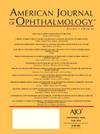Efficacy of Botulinum Toxin Type A for Acute Acquired Comitant Esotropia: An Age-Stratified 2-Year Follow-Up Study
IF 4.1
1区 医学
Q1 OPHTHALMOLOGY
引用次数: 0
Abstract
Purpose
To assess and compare the 2-year follow-up efficacy of botulinum toxin type A (BTXA) in the treatment of acute acquired comitant esotropia (AACE) across five age groups.
Design
Retrospective clinical cohort study.
Methods
A total of 276 patients with AACE who received BTXA injections were enrolled from a single institution between January 2019 and January 2023 (Notably, surgery was recommended for patients >12 years with large-angle esotropia (>50 prism diopters) to reduce failure or recurrence risk). Patients were stratified into five age groups based on intervention age: ≤6 years, >6 to ≤12 years, >12 to ≤20 years, >20 to ≤30 years, and >30 years. The primary outcomes included the cumulative motor and sensory success rates across different age groups, as well as the hazard ratio (HR) for the risk of AACE relapse.
Results
The median age of the 276 participants was 18 years (interquartile range: 9-30 years), with 125 (45.29%) being female. The overall 2-year motor success rate of BTXA for AACE treatment was 69.03% (95% confidence interval [CI]: 62.30%-74.81%). Notably, the motor success rate exhibited a tendency to decline with age, and patients older than 30 years showed significantly lower motor success rate compared to other age groups (≤6 years: 86.53%, >6-≤12 years: 79.96%, >12-≤20 years: 74.08%, >20-≤30 years: 67.45%, >30 years: 44.29%, Bonferroni-corrected posthoc test: P < .05/4). Similarly, patients aged >30 years demonstrated significantly lower rates of stereopsis recovery post-treatment compared to younger cohorts (Bonferroni-corrected posthoc test: P < .05/4). Furthermore, hours of near-work per day (HR: 1.09, 95% CI: 1.01-1.17) and age (HR: 1.04, 95% CI: 1.02-1.06) were identified as significant risk factors for AACE relapse following BTXA injection.
Conclusions
In this retrospective cohort study, our findings demonstrated that younger AACE patients (≤30 years) exhibited significantly greater treatment stability and success rates following BTXA injection therapy. Postoperative preservation or achievement of normal stereopsis can serve as a reliable predictor of reduced recurrence risk.
A型肉毒毒素治疗急性获得性共同性内斜视的疗效:一项年龄分层的两年随访研究。
目的:评估和比较A型肉毒毒素(BTXA)治疗急性获得性共同性内斜视(AACE)在5个年龄组的2年随访疗效。设计:回顾性临床队列研究。方法:在2019年1月至2023年1月期间,共招募了276名接受肉毒毒素注射的AACE患者(值得注意的是,推荐对>12岁的大角度内斜视(>50 PD)患者进行手术,以降低失败或复发风险)。根据干预年龄将患者分为5个年龄组:≤6岁,bbb6 ~≤12岁,>12 ~≤20岁,>20 ~≤30岁,>30岁。主要结果包括不同年龄组的累计运动和感觉成功率,以及AACE复发风险的风险比(HR)。结果:276名参与者的中位年龄为18岁(四分位数间距[IQR]: 9至30岁),其中125名(45.29%)为女性。BTXA治疗AACE的两年整体运动成功率为69.03%(95%可信区间[CI]: 62.30%-74.81%)。值得注意的是,运动成功率随年龄的增长呈下降趋势,30岁以上患者的运动成功率明显低于其他年龄组(≤6岁:86.53%,bbb6 ~≤12岁:79.96%,> 12 ~≤20岁:74.08%,> 20 ~≤30岁:67.45%,> 30岁:44.29%,bonferroni校正后检验:P < 0.05 /4)。同样,与年轻组相比,bb0 ~ 30岁的患者治疗后立体视恢复率明显较低(bonferroni校正的事后检验:P < 0.05 /4)。此外,每天接近工作时间(风险比[HR]: 1.09, 95% CI: 1.01-1.17)和年龄(HR: 1.04, 95% CI: 1.02-1.06)被确定为注射肉毒毒素后AACE复发的重要危险因素。结论:在这项回顾性队列研究中,我们的研究结果表明,年轻的AACE患者(≤30岁)在注射肉毒毒素治疗后表现出更高的治疗稳定性和成功率。术后保留或达到正常立体视觉可作为降低复发风险的可靠预测指标。
本文章由计算机程序翻译,如有差异,请以英文原文为准。
求助全文
约1分钟内获得全文
求助全文
来源期刊
CiteScore
9.20
自引率
7.10%
发文量
406
审稿时长
36 days
期刊介绍:
The American Journal of Ophthalmology is a peer-reviewed, scientific publication that welcomes the submission of original, previously unpublished manuscripts directed to ophthalmologists and visual science specialists describing clinical investigations, clinical observations, and clinically relevant laboratory investigations. Published monthly since 1884, the full text of the American Journal of Ophthalmology and supplementary material are also presented online at www.AJO.com and on ScienceDirect.
The American Journal of Ophthalmology publishes Full-Length Articles, Perspectives, Editorials, Correspondences, Books Reports and Announcements. Brief Reports and Case Reports are no longer published. We recommend submitting Brief Reports and Case Reports to our companion publication, the American Journal of Ophthalmology Case Reports.
Manuscripts are accepted with the understanding that they have not been and will not be published elsewhere substantially in any format, and that there are no ethical problems with the content or data collection. Authors may be requested to produce the data upon which the manuscript is based and to answer expeditiously any questions about the manuscript or its authors.

 求助内容:
求助内容: 应助结果提醒方式:
应助结果提醒方式:


